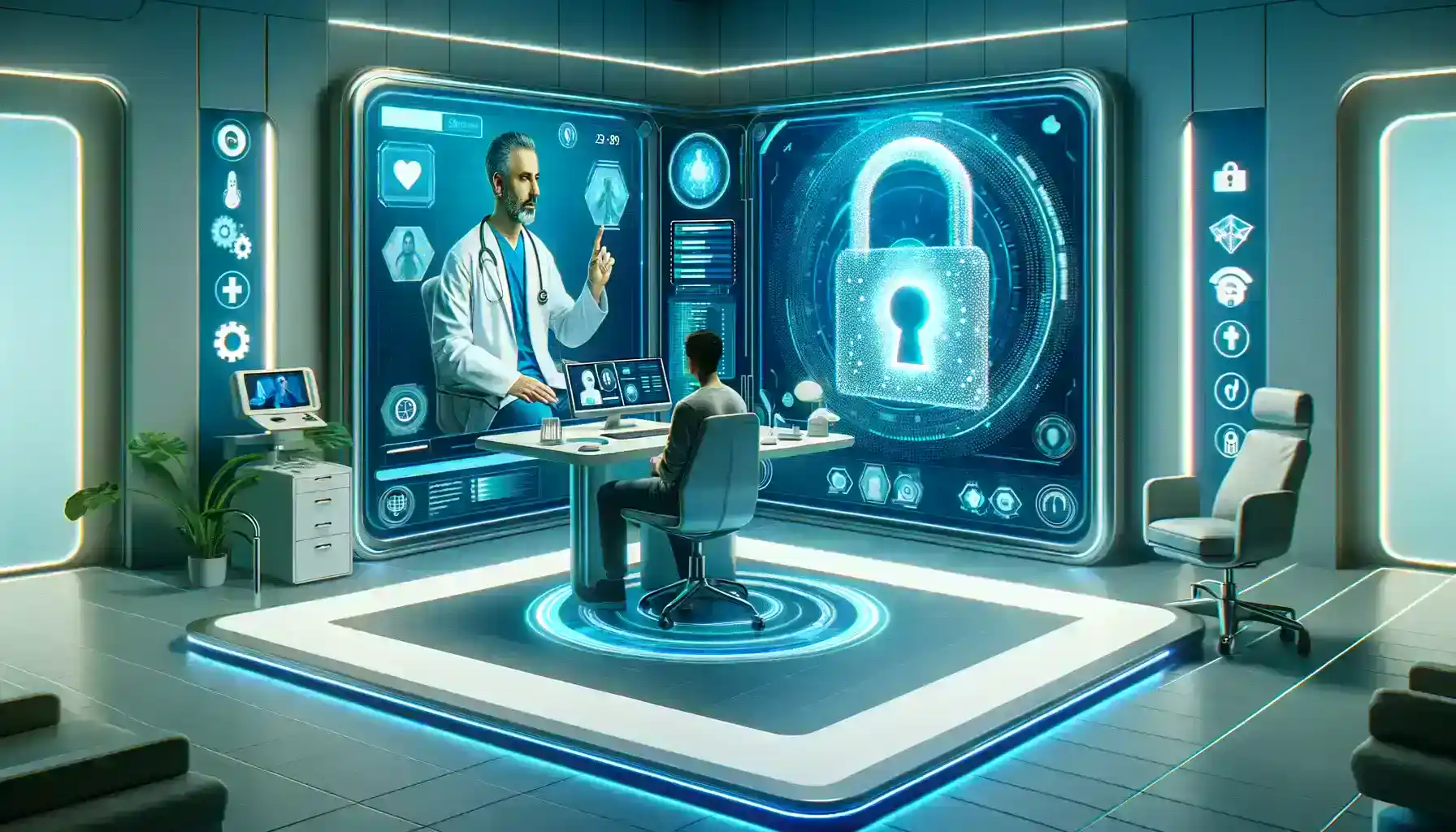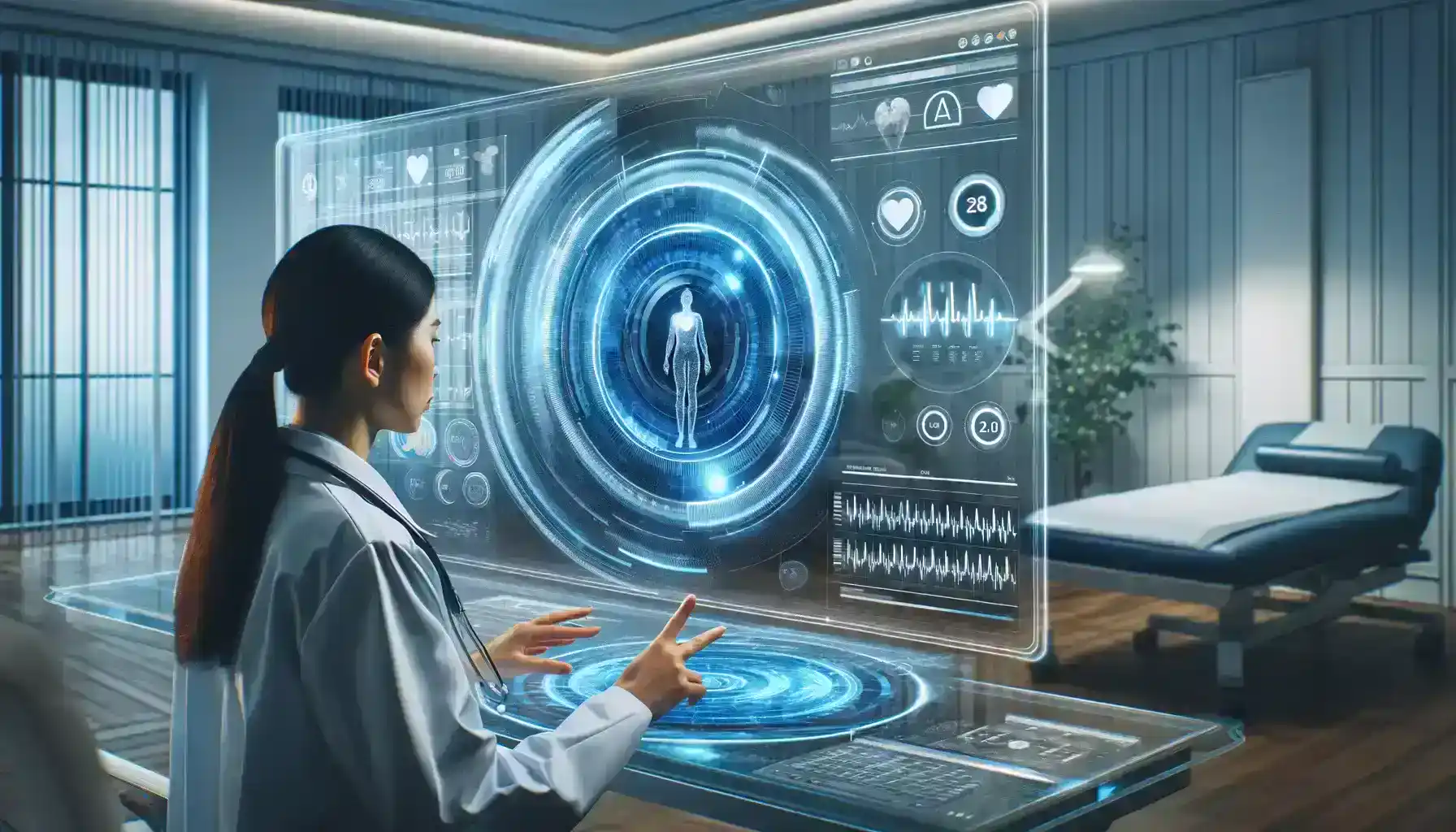Table of Contents
Introduction to Telemedicine in Healthcare 4.0
The dawn of Healthcare 4.0 has been heralded by the surge of telemedicine, a revolutionary approach to medical care that transcends traditional boundaries. Telemedicine, the practice of delivering healthcare services through digital platforms, has been pivotal in transforming patient care. It enhances patient engagement, democratizes access to healthcare, and introduces operational efficiencies unheard of in the pre-digital era.
The catalytic role of telemedicine in modernizing patient care elucidates its impact on accessibility and operational fluidity in healthcare services. Despite the myriad of opportunities it presents and encounters challenges, such as technological disparities and adoption resistance, which this article will address alongside viable solutions.

It is essential to acknowledge that along with the numerous opportunities it presents, telemedicine also faces challenges, including technological disparities and adoption resistance. This article will delve into these aspects and provide viable solutions. It has brought about a transformative impact on the healthcare landscape, particularly in terms of accessibility and operational efficiency.
The integration of telemedicine into healthcare systems worldwide signifies a shift towards a more inclusive, patient-centered model of care, paving the way for innovative solutions to age-old healthcare delivery challenges.
1. The Rise of Telemedicine in Healthcare 4.0
Telemedicine has grown from a niche service to a fundamental aspect of modern healthcare delivery. The evolution of telemedicine has been fueled by rapid advancements in technology, including high-speed internet, mobile connectivity, and the Internet of Medical Things (IoMT). These technological strides have made it possible to provide high-quality healthcare remotely.
For video consultations have become the norm, enabling real-time, face-to-face interactions between patients and healthcare providers. In rural communities, it has been a game-changer, offering access to specialist care that would otherwise be unavailable.
The emergence of smart devices that can monitor vital signs and transmit data in real time has further entrenched telemedicine’s role as an essential component of Healthcare 4.0. Technological advancements, including high-speed internet and smart devices, have enabled real-time, remote interactions between patients and healthcare providers.
The rise of telemedicine in the context of Healthcare 4.0 can be exemplified by the Fiona Stanley Hospital in Australia, which is renowned as one of the first Smart Hospitals in the Indian Ocean region. It has integrated sophisticated digital devices and systems to enhance patient care, and smart building technology to boost the safety, security, and productivity of its operations, while also being energy-efficient.
2. Telemedicine and Patient Empowerment
Empowerment stands at the core of telemedicine’s value proposition. By enabling patients to access healthcare services remotely and hand back control to individuals in managing their health.
A patient with chronic conditions can utilize telemedicine platforms to monitor their health, access educational resources, and communicate with their healthcare team, fostering a proactive approach to health management.
It also empowers patients by shortening wait times for consultations and reducing the need for hospital visits, thus providing a more comfortable and convenient care experience. This empowerment leads to greater patient satisfaction and, ultimately, better health outcomes.

Patients can monitor their health, access educational resources, and communicate with their healthcare teams, leading to greater satisfaction and better health outcomes.
The Veterans Health Administration’s Telehealth Services (VHA) has one of the most extensive telehealth programs in the world. It provides veterans with remote and in-home monitoring, especially for those with chronic conditions. Through the VHA’s telehealth services, patients use devices to record health data such as blood pressure, blood glucose levels, and lung function, and then transmit this data to their healthcare providers.
3. Breaking Barriers with Remote Patient Monitoring
Remote patient monitoring (RPM) is a strategy that epitomizes the breaking down of healthcare barriers. RPM leverages digital technologies to monitor patients outside of conventional clinical settings, such as in the home or in a remote area, which is particularly beneficial for chronic disease management.
Through RPM, healthcare providers can continuously track health data, such as blood pressure or glucose levels, providing timely interventions when necessary.
RPM leverages digital technologies to track patients’ health data outside of traditional clinical settings, especially beneficial for chronic disease management.
Blood glucose meters enable diabetic patients to test their sugar levels regularly, with the data provided to endocrinologists who can tailor medication regimens and management advice, effectively controlling HbA1c levels
4. Data-Driven Healthcare Decisions
Data is the foundation of telemedicine, guiding clinical decision-making and treatment adjustments. Telemedicine not only enhances individual patient care but also contributes valuable data for medical research and public health initiatives.
Data is the lifeblood of telemedicine, informing and guiding clinical decision-making. Telecare platforms gather vast amounts of patient data, from electronic health records (EHRs) to real-time biometric data, which clinicians can analyze to make informed treatment decisions.
Telemedicine can track a patient’s response to treatment over time, allowing for adjustments based on empirical evidence. This approach not only enhances individual patient care but also contributes to the broader knowledge base by providing valuable data for medical research and public health initiatives.
Pharmaceutical companies are using AI to analyze massive chemical compounds and biological interaction datasets to identify potential drug candidates. Atomwise, for instance, uses AI to screen existing drugs for new applications and to design new drug compounds. BenevolentAI uses AI to mine scientific literature and datasets to discover new drug targets and potential treatments for diseases like ALS and Parkinson’s.
5. Integrating AI and Machine Learning
Artificial Intelligence (AI) and machine learning are at the forefront of the telemedicine revolution. These technologies are being harnessed to enhance diagnostic accuracy, personalize treatment plans, and predict patient outcomes. AI-powered chatbots can provide initial consultation services, directing patients to the appropriate care pathway.
Machine learning algorithms, trained on vast datasets, can identify patterns that may indicate the onset of a condition, potentially before the patient is even aware of the symptoms. Such predictive capabilities signify a monumental shift towards preventive medicine, aiming to curb diseases before they escalate.
AI-powered chatbots like those used in customer support and virtual assistants like Siri and Alexa use NLP to understand and respond to human language.

6. Enhancing Accessibility with MHealth Solutions
Mobile health solutions (mHealth) further enhance healthcare accessibility through smartphone apps that support fitness tracking, medication reminders, and mental health support.
The proliferation of smartphones and tablets has paved the way for mobile health (mHealth) solutions, a subset of telemedicine that further enhances healthcare accessibility. mHealth apps can track fitness, provide medication reminders, and even support mental health through meditation and stress relief exercises.
The ubiquity of mobile devices means that remote monitoring can reach a wider audience, ensuring that more people have the tools to manage their health effectively. This strategy has seen significant uptake in managing conditions such as diabetes, where mobile apps assist with tracking blood sugar levels and provide guidance on diet and exercise.
AI-powered mobile apps are used to enhance medication adherence. These apps remind patients to take their medications, provide educational content about their conditions, and monitor their progress. For example, HealthTap’s medication reminder app uses AI to personalize medication schedules and reminders, improving adherence rates and health outcomes.
7. Cybersecurity and Privacy in Telemedicine
Robust cybersecurity measures and adherence to regulations like HIPAA and GDPR are essential to protect sensitive patient data in telemedicine, fostering trust and confidence in remote healthcare services. Ensuring cybersecurity and privacy is central to the sustainable growth of telemedicine, as it reassures patients that their most sensitive information is in safe hands.
As telemedicine relies heavily on the digital transmission of sensitive patient data, robust cybersecurity, and privacy measures are non-negotiable. Healthcare providers must implement stringent security protocols to protect patient information from unauthorized access and cyber threats.
Encryption, secure data storage, and regular security audits are just a few strategies employed to safeguard patient privacy. Additionally, adherence to regulations like the Health Insurance Portability and Accountability Act (HIPAA) in the United States, or the General Data Protection Regulation (GDPR) in the European Union, ensures that telehealth practices meet the highest standards of data privacy and security, fostering trust and confidence in remote healthcare services.
Telemedicine providers establish clear patient consent processes and privacy policies. For example, Teladoc, a telemedicine company, has strict privacy policies that inform patients about how their data will be used and shared.
Conclusion
The emergence of Healthcare 4.0 has ushered in a new era of healthcare delivery, with telecare playing a pivotal role in reshaping the landscape. In this transformative journey, telemedicine has demonstrated its potential to enhance patient care, democratize access to healthcare, and introduce unprecedented operational efficiencies.
The integration of telemedicine into healthcare systems worldwide signifies a shift towards a more inclusive, patient-centered model of care. It not only addresses current healthcare challenges but also paves the way for innovative solutions.
As Healthcare 4.0 continues to evolve, telemedicine will remain a driving force in shaping the future of healthcare, making quality medical care more accessible and efficient than ever before.